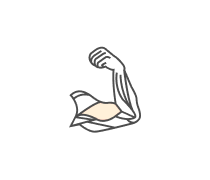Thick & thin myofilaments are formed by proteins called-Pg 157
Any decrease below normal temperature is called-Pg 160
______ anchor muscles firmly to bones.Pg 157
Any increase above normal temperature is called-Pg 160
Most ___muscles attach to two bones that have a movable joint between...
Function: Closes jawPg 168
Each fine thread is a muscle is called a muscle cell or a muscle...
Muscular movement occurs when chemical enery from nutrient molecules...
Attachment of muscle to bone that doesn't move when contraction...
Have a smooth appearance when viewed under the microscope.Pg 156
Function: Raises eyebrowspg 168
When muscles contract simultaneously, the other muscles that relax are...
A quick, jerky response to stimulus.Pg 162
Chemicals called _____ are released by the motor neuron in response to...
Moving a part away from the midline of the body.Pg 173
A movement that makes the angle between two bones at their joint...
Thick myofilaments are made from a protein called-Pg 157
Of all the muscles contracting simultaneously, the one that is manily...
A single motor neuron, with the muscle fibers it innervates is called...
Attachment of muscle to bone that moves when contractions occur.Pg...
Thin myofilaments are made from a protein called-Pg 157
Formation of ____ results in a rapid consumption of oxygen &...
The neuromuscular junction is where ________ meets.Pg 161
Exercise may cause an increase in muscle size called ___.Pg 164
Is a moment around a longitudinal axis.Pg 173
In order to create movement, muscle fibers usually _______.Pg 183
Tendon ______ enclose some tendons.Pg 157
The other muscles that helps in producing the movement are called...
Muscle hypertrophy can be enhanced by-Pg 164
Made of dense, fibrous connective tissues in the shape of heavy...
If muscle fibers are stimulated repeatedly without adequate periods of...
An organ composed mainly of striated muscle fibers & connective...
A type of isotonic contraction wherea muscle produces tension as it...
Skeletal muscle is also referred to as-(Check all that apply)pg 156
What is the smallest functional unit of muscle?Pg 157-159
Muscle fibers are stimulated by a nerve fiber called a __________.Pg...
In a type of isotonic contraction called ____, the insertion end moves...
A contraction that does not always produce movement. Sometimes it...
The shutting off of impulses to certain skeletal muscles results in...
A more sustained and steady response than a twitch.Pg 162
Have unique dark bands called intercalated disks where the plasma...
The minimal level of stimulation required to cause a fiber to contract...
Muscle fibers are said to respond ______.Pg 162
In most cases produces movement of a joint.pg 162
Aerobic training also causes an increase in the number of ______ in...
When maintain body posture because of continuous, low-strenght muscle...
The term _____ describes the continued increased metabolism that must...
The ____ of muscle fibers produces most of the heat required to...
Smooth muscle is also referred to as-(Check all that apply)Pg 156
Functions of skeletal muscles-Pg 159(Select all that apply)
Unique dark bands called _______ where the plasma membranes of...
Tension during muscle lengthening is often called ___ ___.Page 159
Fibers are cylindrical, branch frequently, and then recombine into a...
During prolonged inactivity, muscles usually shrink in mass, a...
Prefixes that refer to muscle-(Select all that apply)Pg 155
Hamstring group-Pg 167(select all that apply)
Quadriceps group-Pg 166(Select all that apply)
What is required for contraction in the sliding filament model?Pg...
Isometric-Pg 164(Choose all that apply)
Isotonic-Pg 164-165(Choose all that apply)
Muscles are named by-(Select all that apply)Pg 183
Adductor Group-Pg 166(Select all that apply)
















